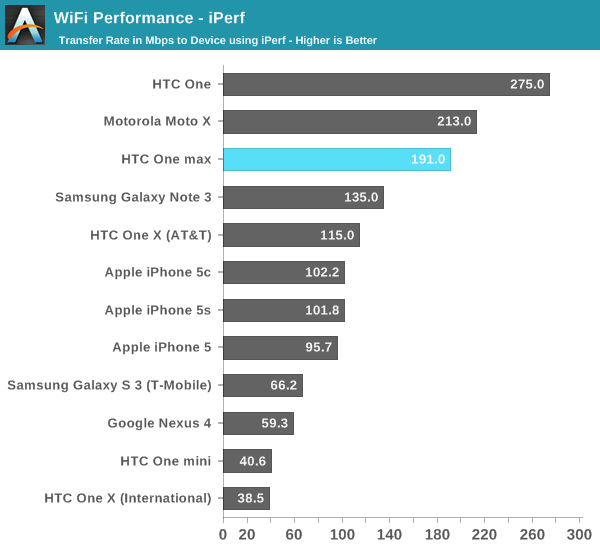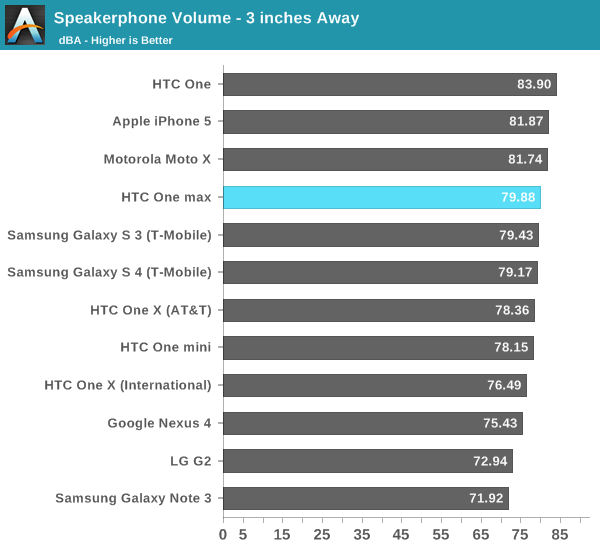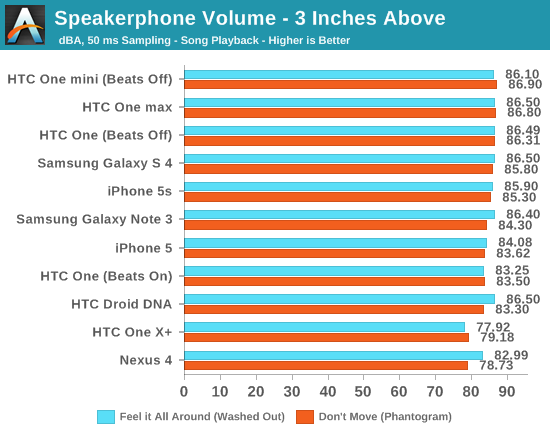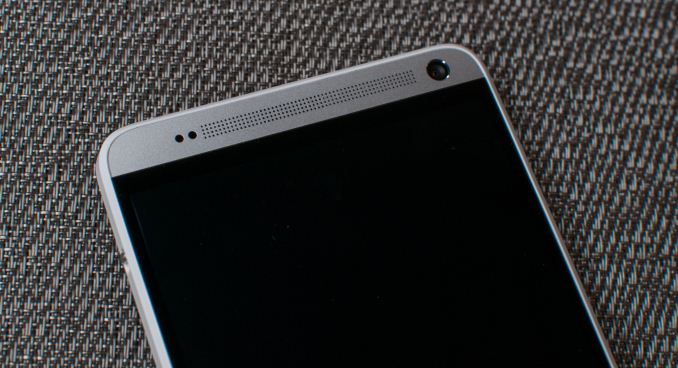HTC One max Review - It's Huge
by Brian Klug on October 28, 2013 10:00 AM EST- Posted in
- Smartphones
- HTC
- Mobile
- One
- Snapdragon 600
- Android 4.3
- One max
Cellular
Cellular on the One max is pretty much the same story as the One, and another shared bullet point. The top and bottom metal cutouts are still the radiative surfaces of the antenna, and there’s still transmit and receive diversity as well to mitigate any unwarranted antenna detuning from holding the device. The unit I was sampled has LTE banding for EMEA (Europe, Middle East, and Africa), but there’s appropriate banding for Asia, Sprint (a tri-mode device with 800/1900 MHz and TDD-LTE on 2600 MHz) and Verizon (700 MHz and AWS), according to the HTC specs page.
The baseband inside the One max is again shared with the One (Qualcomm’s 2nd generation multimode LTE MDM9x15 family), although the One max does have a bit more band support for the USA LTE on Sprint and Verizon, so the front ends are different.
WiFi
Interestingly enough with the One max we see HTC going to Qualcomm Atheros for the WLAN and BT combo, best I can tell this is the WCN3680 which is probably a bit cheaper to include than the BCM4335 we saw in the One. It’s still a single spatial stream 802.11ac capable part, meaning a PHY rate of up to 433 Mbps if you’re in the right channel conditions with 80 MHz channels on 5 GHz. The WCN3680 combo is the 802.11ac successor to WCN3660 which we saw in a number of phones last generation, and is accelerated by the SoC. WCN3680 also does BT 4.0, and FM Rx/Tx if applicable.

To test throughput on the One max I used iPerf the same way I have for a while now. Subjectively there are no complaints from me about WLAN connectivity on the One max, no random dropouts or issues, and Sense 5.5 thankfully still includes the WiFi frequency band manual selection option.
I saw the WCN3680 solution inside Moto X already, it’s interesting to see it in the One max. I believe the One mini uses its 802.11n cousin, WCN3660 as well, probably again for cost reasons.
Speakerphone
Although Beats is gone since that partnership has ended as of the One max, the device still seems to retain everything that made it sound great. There are still the larger-than-typical speaker chambers, big speaker grilles on the top and bottom, stereo sound, and importantly the TFA9887 speaker amplifier and protection part from NXP. In addition there’s still the TPA6185 headphone amplifier as well.
Beats always seemed to be an audio compressor that ran on the DSP, ostensibly through the Hexagon DSP access program or something, and that’s what’s absent on the One max. There’s no toggle under settings for enabling or disabling it, nor the Beats branding, but to be honest I almost always disabled Beats on the One anyways since it was a fair amount louder with it disabled. What made the One great was all the hardware behind the speakers, not so much the software compressor.


The One max goes plenty loud just like the original One. I went ahead and added the One mini and 5s to the chart too, just to check whether things have changed much, in addition to the Galaxy S 4 and Note 3. The One max basically performs like the One with Beats turned off, which isn’t a surprise since it isn’t there anymore. There’s also no detectable saturation, and the One line remains the only device that doesn’t sound tinny or rattly with overemphasized highs and lacking mids. I suspect the A weighting I selected a while ago for measuring might be a contributing factor as well. Either way you’re not going to be wanting for more loudness on the One max, and the inclusion of front firing stereo speakers makes for a completely different listening experience.












197 Comments
View All Comments
PC Perv - Tuesday, October 29, 2013 - link
Hah. At least you are being honest here. Of course you won't review anything unless you get it for free. (and then some)Black Obsidian - Tuesday, October 29, 2013 - link
This isn't the glory days of the dot-com boom. Few (if any) sites have the kind of budget that allows them to go out and buy whatever random devices their readership expects them to review.I'm sure that Brian would consider reviewing your favored device if you wanted to send him one, though.
JMFL - Monday, October 28, 2013 - link
Mostly decent review, except in my opinion Brian's equivocation regarding the finger print sensor in comparison to Apple's. To be fair Brian stated that the One Max sensor is "further from perfection than Apple's", however from reading the rest of the text, one could come to the conclusion that in the grand scheme of things the HTC's and Apple's sensors are more similar than not.I would hazard to guess that in 6 months time, most Iphone 5S users will be using the fingerprint scanner. I don't think the same will be said for the HTC Once Max sensor.
ddriver - Monday, October 28, 2013 - link
It doesn't really matter what apple does, everything apple does is amazing because it is done by apple by default. IIRC the review at engadget: "note 3 - cheap plastic - product sucks" and then "iphone 5c - amazing plastic - product rocks".Things have come to a point you cannot really expect honesty from review sites, no matter how "trusted" they themselves claim to be.
Fingerprint readers are a government sponsored scam to build fingerprint databases for god knows what ill purposes, glad I got the note 3 as it looks like the note 4 will have a fingerprint sensor as well. Fingerprints are considered lower security level than even passwords, a password is in the brain, a fingerprint can be extracted from everything you touch.
blacks329 - Monday, October 28, 2013 - link
People perceive (whether correctly or incorrectly) that rigidity in their phone means it is a more durable device and that the rigidity give a better in hand feel.The iPhone 5C feels really solid, like the Lumia's, there's no flex. So I can understand the merits of claiming "cheap" plastic.
steven75 - Thursday, October 31, 2013 - link
It doesn't matter how many times you tell this to ddriver. He has made up his mind that material usage is a binary thing.Spunjji - Monday, October 28, 2013 - link
"For the incredibly small percentage of users that clamors for an SD card every single smartphone launch, it’s at least one point which won’t be belabored so tiresomely this time."Gee, thanks for making me feel like a dick for not wanting to pony up £80 for £10 worth of low performing NAND.
We get it, you don't think these things are worthwhile. That's your opinion and you're entitled to it. That doesn't justify a paragraph of text dedicated to mocking and marginalising a chunk of your readership. It devalues your opinion.
themossie - Monday, October 28, 2013 - link
Agreed. Brian, you write superb reviews but that has no place here.kmmatney - Monday, October 28, 2013 - link
I agree. I've been an iPhone user for 4 years, but switched to the Optimus G Pro (also a huge 5.5" phone) and one of the draws was expanding the storage. It's a big enough phone to be able to read work instructions quite easily, so I have a lot of PDFs and documents on it, as well as 20GB of music. More storage never hurts. I didn't have too much trouble filling up my 32GB iPhone. I can live without it, but if choosing between 2 phones, and one has it and noe doesn't, you might as well buy the phone with more options.Brian Klug - Monday, October 28, 2013 - link
See my above comment, the reality is that it is a very tiny part of the market, and an exceptionally loud one.-Brian